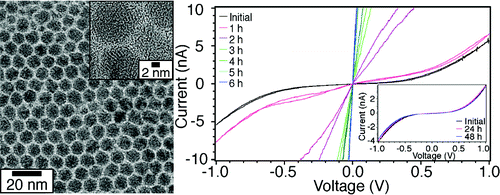当前位置:
X-MOL 学术
›
J. Am. Chem. Soc.
›
论文详情
Our official English website, www.x-mol.net, welcomes your
feedback! (Note: you will need to create a separate account there.)
Cu2Se Nanoparticles with Tunable Electronic Properties Due to a Controlled Solid-State Phase Transition Driven by Copper Oxidation and Cationic Conduction
Journal of the American Chemical Society ( IF 14.4 ) Pub Date : 2011-02-09 , DOI: 10.1021/ja106254h Shannon C. Riha 1 , Derek C. Johnson 1 , Amy L. Prieto 1
Journal of the American Chemical Society ( IF 14.4 ) Pub Date : 2011-02-09 , DOI: 10.1021/ja106254h Shannon C. Riha 1 , Derek C. Johnson 1 , Amy L. Prieto 1
Affiliation

|
Stoichiometric copper(I) selenide nanoparticles have been synthesized using the hot injection method. The effects of air exposure on the surface composition, crystal structure, and electronic properties were monitored using X-ray photoelectron spectroscopy, X-ray diffraction, and conductivity measurements. The current-voltage response changes from semiconducting to ohmic, and within a week a 3000-fold increase in conductivity is observed under ambient conditions. The enhanced electronic properties can be explained by the oxidation of Cu(+) and Se(2-) on the nanoparticle surface, ultimately leading to a solid-state conversion of the core from monoclinic Cu(2)Se to cubic Cu(1.8)Se. This behavior is a result of the facile solid-state ionic conductivity of cationic Cu within the crystal and the high susceptibility of the nanoparticle surface to oxidation. This regulated transformation is appealing as one could envision using layers of Cu(2)Se nanoparticles as both semiconducting and conducting domains in optoelectronic devices simply by tuning the electronic properties for each layer through controlled oxidation.
中文翻译:

由于铜氧化和阳离子传导驱动的受控固态相变,Cu2Se纳米粒子具有可调电子特性
已使用热注射法合成了化学计量的硒化铜 (I) 纳米粒子。使用 X 射线光电子能谱、X 射线衍射和电导率测量监测空气暴露对表面组成、晶体结构和电子特性的影响。电流-电压响应从半导体变为欧姆,并且在一周内观察到在环境条件下电导率增加了 3000 倍。增强的电子特性可以通过纳米颗粒表面上 Cu(+) 和 Se(2-) 的氧化来解释,最终导致核心从单斜 Cu(2)Se 固态转换为立方 Cu(1.8)硒。这种行为是晶体内阳离子 Cu 易于固态离子电导率和纳米颗粒表面对氧化的高度敏感性的结果。这种受调控的转变很有吸引力,因为人们可以设想通过受控氧化来调整每一层的电子特性,从而将 Cu(2)Se 纳米颗粒层用作光电器件中的半导体和导电域。
更新日期:2011-02-09
中文翻译:

由于铜氧化和阳离子传导驱动的受控固态相变,Cu2Se纳米粒子具有可调电子特性
已使用热注射法合成了化学计量的硒化铜 (I) 纳米粒子。使用 X 射线光电子能谱、X 射线衍射和电导率测量监测空气暴露对表面组成、晶体结构和电子特性的影响。电流-电压响应从半导体变为欧姆,并且在一周内观察到在环境条件下电导率增加了 3000 倍。增强的电子特性可以通过纳米颗粒表面上 Cu(+) 和 Se(2-) 的氧化来解释,最终导致核心从单斜 Cu(2)Se 固态转换为立方 Cu(1.8)硒。这种行为是晶体内阳离子 Cu 易于固态离子电导率和纳米颗粒表面对氧化的高度敏感性的结果。这种受调控的转变很有吸引力,因为人们可以设想通过受控氧化来调整每一层的电子特性,从而将 Cu(2)Se 纳米颗粒层用作光电器件中的半导体和导电域。































 京公网安备 11010802027423号
京公网安备 11010802027423号